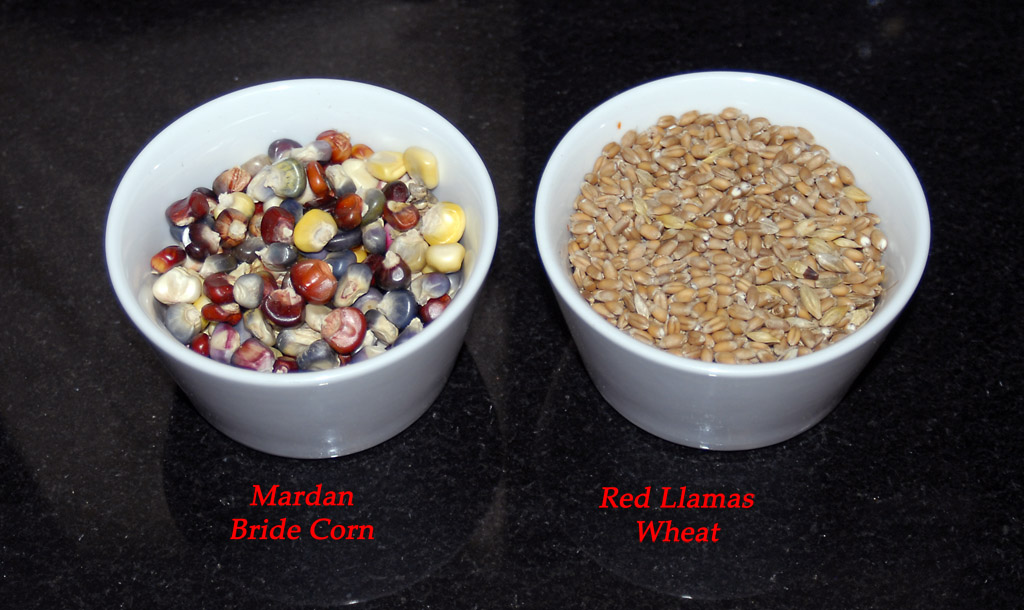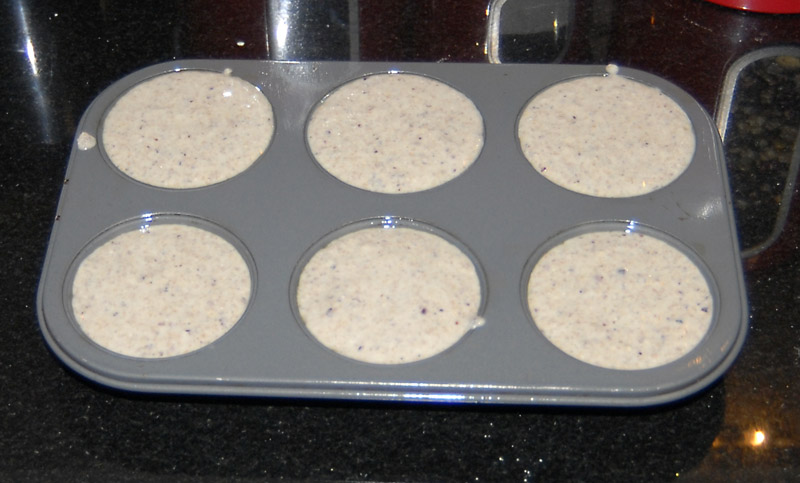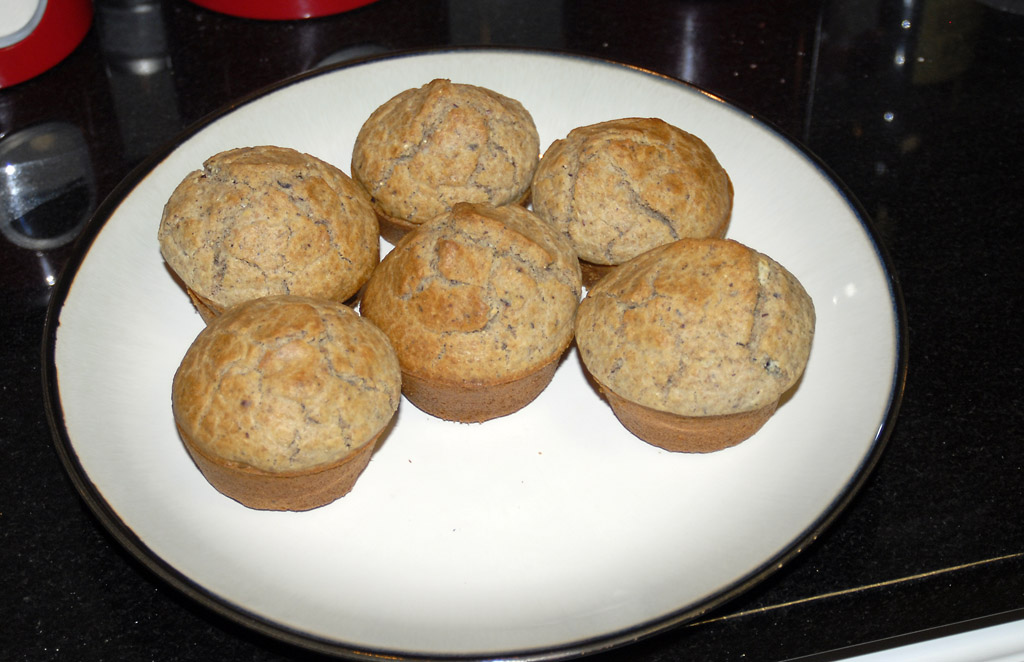
Mandan Bride Corn Cornbread
Saturday was pickup day for Pioneer Valley's grain CSA. I am really impressed with the variety and quality of the grains and beans we got. I'll do a more extensive post on what we got later, but here's the first cooking effort. I used the same recipe from my blue corn cornbread entry, using Red Llamas Wheat and Mandan Bride Corn.
The Bride Corn kernels were so big that my mill had a hard time 'grabbing' them and pulling them into the stone. I ended up having to mill it twice -- the first time with the outer wheel very loose to get a coarse, rough grind, and then a second pass at a finer setting. It was a pain in the butt, but it worked.
The flavor of the final product was superb, I paired the bread with a berebere-rubbed pot roast with yams and carrots.





Comments
Great looking muffins, Loyd! Easy, effortless, and convenient! Thanks
It took longer to mill the flour than to cook it I think :)
What's the story behind Red Llamas Wheat? Nice plump looking grains. Oughta mill nicely.
Cheers,
Tom
I don't know anything about the wheat. The two varieties we got were Arapaho and Red Llama. I'm tentatively treating it like red winter wheat. We'll see, I'll make some bread with it soon.
Heirloom Red Llamas (hard red winter wheat) - hard wheat, good for milling and pastry baking (muffins, pancakes, cakes, scones, etc). We haven’t tested this one yet as a bread wheat, but it may be suitable for that, also. Also suitable for cooking and eating as whole wheat berries, on salads, in soups, sprouted or drizzled with honey for dessert! Can be ground coarser and cooked as breakfast porridge.
Loydb,
I use hard red winter wheat almost every week to make bread using the Tassajara Bread Book honey whole wheat recipe (an old standard in our house). I find the fresh milled flour from this wheat to be very quick to rise. A sponge that may sit for 1 hour will usually be ready in about 40-45 minutes, bulk ferment and proofing times are quick too. Is this just a characteristic of all fresh milled wheat? The wheat I use is Expresso hard red winter wheat. It will be interesting to see what your experience is of the Red Llamas.
Linda
I do mostly sourdough, and find that fresh whole wheat rises more slowly than AP flour or commercial-milled WW flour. I've always assumed this was because of larger 'chunks' of bran. Maybe it reacts differently to baker's yeast?
and your muffins are a great advertisement for the PV CSA. Where do you pick it up? -Varda
Amherst, MA. It was about a 2 hour drive from Providence.
Loydb,
What make/model of grain mill do you use for the corn? I'm curious because I have a Komo mill and I'm not sure it will do corn. Those muffins sure look tasty. Wish we had a grain CSA here in CA.
Linda
I use a Retsel Mill-Rite with the steel wheels on it. Next time, I'll sift the meal after the first run, too much fine flour in the hopper tends to cause it to stop feeding until you break up the compression.
That's what I've been doing with my KA grain mill, milling wheat, rye or toasted bran and wheat germ. Mill output drops directly onto 50# sieve sitting over catch-bowl. Only what stays in the sieve (after shaking it a lot) gets re-milled (on a finer setting) each pass. Takes 5-6 passes of retained fractions at 3-4 successively finer settings to get 80% extraction. Wheat I've experimented with was pretty old and dry (fairly shriveled compared to your plump Red Llama). Rye however was a dream. Wish I liked to bake with it more -- use tiny amounts in levains mostly.
Tom
I find that using rye in 5-10% of the grain bill adds a great depth of flavor without ever tasting like "rye" and without significantly impacting gluten formation. I like 100% rye sourdoughs, but not very often (usually as an accompaniment to a cheese tray or pate).
Hi Linda,
I have a KoMo and when I do corn I always mill 2x. First on the course setting and then to a finer setting once the pieces are smaller. Works the same way with large beans like garbanzos.
Janet
What do you do with the ground beans?
The ground garbanzos make Indian besan (chickpea flour) and are used in a number of Indian recipes. Garbanzo flour is also well tolerated by those who have gluten intolerance. Garbanzo flour, shredded zucchini, salt, and baking soda combined with a dash of cayenne formed into balls and fried make great zucchini fritters (khofta).
love their Garbanzos and even make the most unusual 100% garbanzo bean pizza that is more like thinnish batter poured into a an oiled pan and then baked. Delicious! I sometimes add Chi Chi flour to regular pizza dough to give it a better taste and improve its extensibility. It is also nice in other multi-grain (and Bean) breads in smaller amounts. It can also be used to thicken soups or add extra flavor to garbanzo bean soup or to add thickening to a thin hummus.
Thank you, Janet. I'll have to give that a try - I've been buying besan(chickpea flour).
Quintessential street/railway platform snack in Pakistan & India: bits of veg in spicy besan batter, deep fried (re-fried while you wait), wrapped in newspaper like fish 'n chips in UK. Mmm good.
t
home ground grains and the corn muffins have to be spectacular after seeing the corn! Can't find anything on Red Llamas Wheat though. Nice baking and thanks for the mill info too!
we used to grow corn like this my mother called it squaw corn (and before you get outraged at the politically incorrect name it was the 1950's) which my grandfather had gotten the original corn seed from the Mandan Indians (he traded with them in the late 1800's) and also brought lovely Mandan beans (his name) which were tiny yellow beans which had two forms of plant, one grew viney and one grew bush but both were the same bean. Mom said they grew them together in the same hill in the corn patch, the beans and the corn supported each other and were part of the three sisters lacking the squash.